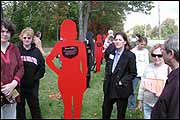UU church display a reminder of domestic violence
Silhouettes of slain women memorialize domestic homicides.
This is the 11th year of the church’s exhibition, which runs during October, domestic violence month. The idea for the exhibition comes from the Silent Witness National Initiative, founded in Minnesota in 1990 to make people aware of the often hidden problem of domestic violence. The UU Fellowship of Harford County in Churchville, Md., also exhibits figures for its county.
Lemmey was drawn to the issue when she discovered that her sister was the victim of domestic violence. “I had absolutely no idea this was going on,” she said, “but it was 1982 and you didn’t talk about these things. I later heard it had been going on for ten years.” A newly minted nurse, she set out to educate herself on the causes of domestic violence. In 1994 she read an article about the Silent Witness program at about the same time another domestic homicide occurred in Lake County. “It really shook a lot of people up,” she said, so she approached the church board to get their approval to start the Silent Witness program at East Shore. That was in 1995. Since then the congregation has taken on domestic violence as one of its social justice issues, donating funds and services to three battered women’s shelters. In November it will refurbish a room at a transitional housing project in Cleveland.
At one point Lemmey had some doubts about whether the exhibit was important when compared with the effects of large national tragedies. “It was right after 9/11,” she recalls, “and I really wondered, ‘do we want to do this?’ Then I read an ancient Ghanaian proverb, ‘The ruin of a nation begins in the homes of its people.’ And that gave me the affirmation I needed.”
Each shield bears the name of a woman killed by an intimate partner along with her age and the details of her death. “We don’t do a figure unless we’ve read the story in the newspaper,” Lemmey said. “There are some relatives of victims who request that we don’t do this because they don’t consider it domestic violence,” Lemmey added. “We honor that.” In many of the cases of homicide, the perpetrator shoots himself after killing one or more family members.
Some victims’ relatives come to see the figures. Lemmey wrote in the church newsletter about meeting the mother of one of the women represented in the display after the dedication this year. “She spoke through sobs about the day her son-in-law broke into her house where her daughter was hiding, stabbed her daughter, then left looking for the sister and stabbed her and her husband,” Lemmey said. “Then he left and stabbed himself.”
The Rev. Dr. Nicole Kirk, who was the congregation’s minister from 1998 to 2006, spoke several times on the issue of violence. “These figures resemble images of women we could have known: a sister, a friend, a daughter, a mother,” she said in a 2001 speech given at the beginning of a fundraising walk for domestic violence. “Their presence speaks of the terrible secret of abuse in family and intimate relationships.”
Even if domestic violence is not a factor in our own lives, there’s a good chance we know someone who is being abused or who grew up with it as a child, Lemmey said. The total number of domestic homicides has fallen by almost half since 1976, according to the Silent Witness National Initiative website. But this is because the number of men killed by women has dramatically fallen. “Women now have options that don’t include shooting,” Lemmey said. In 1976 the number of female homicide victims was 1,596; in 2004 women accounted for 1,159 of the total 1,544 victims, according to the Silent Witness National Initiative.
Delegates to the Unitarian Universalist Association of Congregations’ General Assembly passed formal resolutions calling for an end to domestic violence in 1979 and 1993.
The exhibit has had unexpected effects. Bill Butler, an East Shore member since 1973 and former chair of the social justice committee, said, “It made me realize in my own life when I was a teen what my mother went through with domestic violence.” In retrospect Butler said he could better understand the family dynamics leading to the abuse: “My father had a mental illness that precipitated this. I really didn’t feel the whole impact at that time.”
See sidebar for links to related resources.








